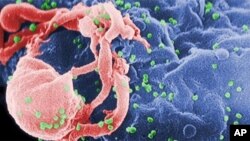Just a few years ago, creating an AIDS-free generation would have been unimaginable, said Secretary of State Hillary Clinton in early November to a gathering of scientists. That is why, until now, it has never been a policy priority for the United States Government, she said:
"Today, thanks both to new knowledge and to new ways of applying it, we have the chance to give countless lives and futures to millions of people who are alive today, but equally, if not profoundly more importantly, to an entire generation yet to be born."
An AIDS-free generation, said Secretary Clinton, is one where no children are born with the virus; and as they grow to adulthood, they have only a very low chance of becoming infected with HIV, thanks to a wide range of effective preventive measures; and that if they do contract HIV, they will have access to treatment and will never develop AIDS, or pass the virus to others.
"HIV may be with us well into the future," said Secretary Clinton, "but the disease that it causes need not be."
We can do this in three steps: using medication to stop mother-to-child transmission during pregnancy and at birth; expanding voluntary male circumcision, which is an effective means of lowering HIV transmission rates; and intensifying drug treatment for HIV-positive persons, proven to reduce the virus in the bloodstream and to lower the risk of transmission. When used in combination with condoms and other prevention tools, these three interventions offer an historic opportunity to diminish the worldwide rate of new infection.
The United States leads the world in HIV/AIDS research and development. Through PEPFAR, the U.S. runs prevention programs, and provides medication and access to treatment to some of the world's neediest populations. During her speech, Secretary Clinton announced an additional 60 million dollars to fund a rapid scale-up of combination prevention strategies in four sub-Saharan African nations.
"When so many people are suffering and we have the means to help them, we have an obligation to do what we can," said Secretary Clinton. "Let’s not stop now. Let’s keep focused on the future. And one of those futures that I hope we can be part of achieving is an AIDS-free generation."
Towards An AIDS-Free Generation

Just a few years ago, creating an AIDS-free generation would have been unimaginable.
















